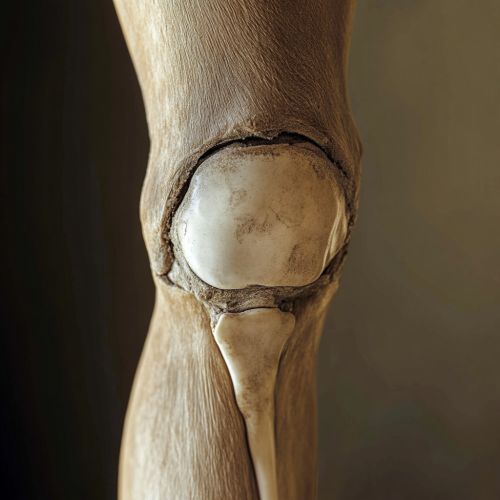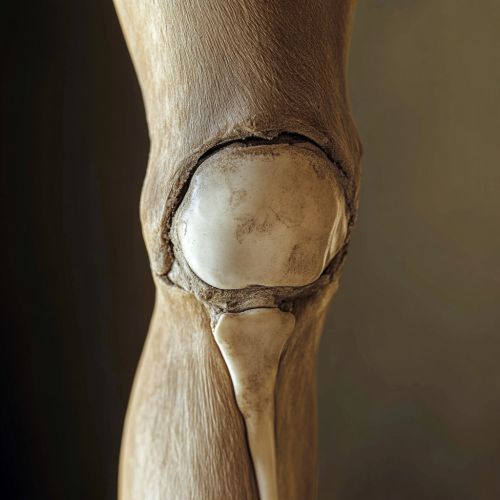Osteoarthritis: Difference between revisions
(Created page with "== Introduction == Osteoarthritis (OA) is a degenerative joint disease characterized by the breakdown of cartilage and underlying bone. It is the most common form of arthritis, affecting millions of people worldwide. The condition typically manifests as joint pain, stiffness, and reduced mobility, primarily impacting the knees, hips, hands, and spine. Unlike inflammatory arthritis, osteoarthritis is primarily a mechanical issue, although inflammation can play a secondary...") |
No edit summary |
||
| Line 53: | Line 53: | ||
A grating or cracking sound may be heard during joint movement, caused by the roughened surfaces of the cartilage and bone. | A grating or cracking sound may be heard during joint movement, caused by the roughened surfaces of the cartilage and bone. | ||
[[Image:Detail-97611.jpg|thumb|center|A close-up photograph of a human knee joint affected by osteoarthritis, showing visible swelling and deformity.|class=only_on_mobile]] | |||
[[Image:Detail-97612.jpg|thumb|center|A close-up photograph of a human knee joint affected by osteoarthritis, showing visible swelling and deformity.|class=only_on_desktop]] | |||
== Diagnosis == | == Diagnosis == | ||
Latest revision as of 07:34, 14 August 2024
Introduction
Osteoarthritis (OA) is a degenerative joint disease characterized by the breakdown of cartilage and underlying bone. It is the most common form of arthritis, affecting millions of people worldwide. The condition typically manifests as joint pain, stiffness, and reduced mobility, primarily impacting the knees, hips, hands, and spine. Unlike inflammatory arthritis, osteoarthritis is primarily a mechanical issue, although inflammation can play a secondary role.
Pathophysiology
Osteoarthritis involves the entire joint, including the cartilage, subchondral bone, synovium, ligaments, and muscles. The disease process begins with the degradation of articular cartilage, a smooth tissue that covers the ends of bones in a joint. This degradation is often due to mechanical stress and biochemical changes within the joint.
Cartilage Degradation
Articular cartilage is composed of chondrocytes embedded in an extracellular matrix (ECM) rich in collagen and proteoglycans. In osteoarthritis, the balance between anabolic and catabolic processes in the cartilage is disrupted. Enzymes such as matrix metalloproteinases (MMPs) and aggrecanases degrade the ECM, leading to cartilage erosion.
Subchondral Bone Changes
The subchondral bone, located just below the cartilage, undergoes sclerosis and the formation of osteophytes (bone spurs). These changes contribute to joint stiffness and pain. The increased bone density and abnormal bone growth are thought to be a response to the altered mechanical environment within the joint.
Synovial Inflammation
Although osteoarthritis is not primarily an inflammatory condition, low-grade inflammation of the synovium (the lining of the joint) can occur. This inflammation is characterized by the infiltration of immune cells and the production of pro-inflammatory cytokines, which can exacerbate cartilage degradation.
Risk Factors
Several risk factors contribute to the development and progression of osteoarthritis:
Age
Age is the most significant risk factor for osteoarthritis. The prevalence of the condition increases with age, particularly after the age of 50.
Gender
Women are more likely to develop osteoarthritis than men, especially after menopause. Hormonal changes are believed to play a role in this increased risk.
Genetics
Genetic factors contribute to the susceptibility to osteoarthritis. Specific gene mutations affecting collagen and other components of the cartilage matrix have been linked to the disease.
Obesity
Obesity is a major modifiable risk factor for osteoarthritis, particularly in weight-bearing joints like the knees and hips. Excess body weight increases mechanical stress on the joints and can also contribute to systemic inflammation.
Joint Injury
Previous joint injuries, such as those sustained during sports or accidents, can increase the risk of developing osteoarthritis. Injuries can lead to joint instability and abnormal loading, accelerating cartilage wear.
Occupational and Physical Activity
Occupations and activities that involve repetitive joint use or heavy lifting can increase the risk of osteoarthritis. Conversely, moderate physical activity is generally protective and beneficial for joint health.
Clinical Presentation
Osteoarthritis typically presents with the following symptoms:
Pain
Joint pain is the most common symptom of osteoarthritis. It is usually exacerbated by activity and relieved by rest. In advanced stages, pain may occur even at rest.
Stiffness
Morning stiffness lasting less than 30 minutes is characteristic of osteoarthritis. Stiffness may also occur after periods of inactivity.
Swelling
Joint swelling can occur due to synovial inflammation and the presence of osteophytes.
Reduced Range of Motion
As the disease progresses, joint mobility decreases due to pain, stiffness, and structural changes within the joint.
Crepitus
A grating or cracking sound may be heard during joint movement, caused by the roughened surfaces of the cartilage and bone.


Diagnosis
The diagnosis of osteoarthritis is primarily clinical, based on patient history and physical examination. Imaging and laboratory tests are used to confirm the diagnosis and rule out other conditions.
Clinical Examination
The clinical examination includes an assessment of joint pain, stiffness, swelling, and range of motion. The presence of crepitus and bony enlargements (Heberden's and Bouchard's nodes) are also noted.
Imaging
Radiographic imaging is the most commonly used modality for diagnosing osteoarthritis. X-rays can reveal joint space narrowing, osteophyte formation, subchondral sclerosis, and cysts. Magnetic resonance imaging (MRI) is used in certain cases to assess soft tissue structures and early cartilage changes.
Laboratory Tests
Laboratory tests are not specific for osteoarthritis but are used to exclude other types of arthritis, such as rheumatoid arthritis or gout. Tests may include erythrocyte sedimentation rate (ESR), C-reactive protein (CRP), and synovial fluid analysis.
Management
The management of osteoarthritis involves a combination of non-pharmacological, pharmacological, and surgical interventions aimed at reducing pain, improving function, and slowing disease progression.
Non-Pharmacological Interventions
Non-pharmacological approaches are the cornerstone of osteoarthritis management and include:
Education and Self-Management
Patient education about the disease, its progression, and management strategies is crucial. Self-management programs can empower patients to take an active role in their care.
Physical Therapy
Physical therapy focuses on exercises to strengthen the muscles around the affected joint, improve range of motion, and reduce pain. Techniques may include aerobic exercises, resistance training, and flexibility exercises.
Weight Management
Weight loss is recommended for overweight or obese patients to reduce mechanical stress on weight-bearing joints.
Assistive Devices
The use of assistive devices such as braces, orthotics, and canes can help reduce joint load and improve mobility.
Pharmacological Interventions
Pharmacological treatments aim to relieve pain and inflammation. Commonly used medications include:
Analgesics
Acetaminophen is often the first-line analgesic for mild to moderate pain. It is preferred due to its safety profile.
Nonsteroidal Anti-Inflammatory Drugs (NSAIDs)
NSAIDs, such as ibuprofen and naproxen, are used for their anti-inflammatory and analgesic effects. However, long-term use is associated with gastrointestinal, cardiovascular, and renal risks.
Topical Agents
Topical NSAIDs and capsaicin creams can be applied directly to the affected joint to reduce pain with minimal systemic side effects.
Intra-Articular Injections
Corticosteroid injections can provide short-term pain relief for inflamed joints. Hyaluronic acid injections are also used to improve joint lubrication and reduce pain.
Surgical Interventions
Surgery is considered for patients with severe osteoarthritis who do not respond to conservative treatments. Surgical options include:
Arthroscopy
Arthroscopy involves the minimally invasive removal of loose cartilage fragments and the smoothing of rough cartilage surfaces. Its efficacy in osteoarthritis is debated.
Osteotomy
Osteotomy involves the surgical realignment of bones to redistribute weight and relieve pressure on the affected joint.
Joint Replacement
Total joint replacement (arthroplasty) is the most definitive surgical treatment for end-stage osteoarthritis. It involves replacing the damaged joint with a prosthetic implant. Commonly replaced joints include the hip and knee.
Prognosis
The prognosis of osteoarthritis varies depending on the severity and location of the disease, as well as the patient's overall health and adherence to treatment. While osteoarthritis is a chronic condition with no cure, many patients can manage their symptoms effectively and maintain a good quality of life with appropriate interventions.
Research and Future Directions
Ongoing research in osteoarthritis aims to better understand the disease mechanisms and develop new treatments. Areas of interest include:
Biomarkers
The identification of biomarkers for early diagnosis and monitoring disease progression is a key research focus. Biomarkers could help tailor treatments to individual patients.
Disease-Modifying Osteoarthritis Drugs (DMOADs)
Researchers are investigating potential DMOADs that could slow or halt the progression of osteoarthritis. These drugs target various pathways involved in cartilage degradation and inflammation.
Regenerative Medicine
Regenerative approaches, such as stem cell therapy and tissue engineering, hold promise for repairing damaged cartilage and restoring joint function. Clinical trials are ongoing to evaluate the safety and efficacy of these therapies.
